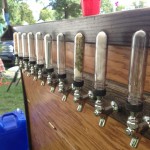September 26, 2013

Dr. Frankenbeer, I presume
Being a new brewer is exciting. You open the box, and there’s this fermenter, and cans of extract, and instructions, and you can make beer! I got my start with a Mr. Beer kit my wife got me for Christmas. I was as excited as a ten-year-old getting a puppy, and I couldn’t wait to brew my first batch. I would have creative control of the beer I drank. There were so many possibilities now; so much potential for creating custom beers right in my own kitchen.
My first couple of batches were done with some slight modifications. Nothing major; just a little honey addition in the first one, and a little bit of brown sugar in the second one. I was pleased with them, and was eager to try more modifications on my next batches. My third batch was a Pale Ale that I decided to modify with some pureed strawberries. It was the weirdest beer I’ve ever made. Not just the taste, which was sometimes sweet with a strawberry flavor and sometimes bitter with a fruity undercurrent. But some bottles gushed when I opened them, and others seemed flatter than they should have. In retrospect, I’m glad I had this puzzling batch early on, because it made me stop and think about my approach to this whole endeavor.
What I concluded was this: I was too inexperienced to experiment. I was trying to be a Mad Scientist, but the problem was, I wasn’t even a scientist at that point. Quite simply, I didn’t know what I was doing or what I was working with. The world of brewing is a vast playground, and the selection of styles is enormous, from simple Bitters and Blonde Ales to Imperial Stouts and spiced Porters. Each of these styles have their own signatures. A Cream Ale may resemble an American Light Lager in appearance, but the flavors are quite different. And all styles can be modified and customized, but to be successful at it, an understanding of the style must come first. And understanding the style can only be attained by knowing the ingredients.

My point is, when you’re beginning, it’s best to stick with the basics, because you’re learning a new set of skills, as well as learning the flavor profiles of your ingredients. There’s no need to rush. Learn HOW first. Then learn WHAT you’re making, and what you like. When you have a firm footing in the process, and once you have a sense of what the extracts bring to the table, you can make more informed choices about how to modify them and customize your beer.
Another modification many new brewers want in their beer is higher alcohol content, or ABV. After all, you’re the brewer! You’re in control! You have the ability to make a beer that’ll really knock you on your keister! Well, yes, that’s true, but be careful how you approach it. Pretty much all sugar will ferment and turn to alcohol, but there’s more to beer than that. Beer has body and flavors that comes from non-fermentable ingredients in the malt. Tossing sugar into the wort increases the amount of fermentable sugar (and the alcohol percentage). But it throws the balance of the body and flavors out of whack. Too much pure sugar thins a beer out and makes it taste cidery. It will take more time to condition properly, if it ever does, and you may have a high ABV beer without much flavor. The recommended method of increasing ABV without sacrificing body is to use more malt, generally in the form of Dry or Liquid Extract. But be advised, more malt can also throw the bitterness out of balance by masking the hops with more malt sweetness. The signature flavor of that IPA, with its crisp hops bitterness may not be the same after adding more malt. It’s a delicate balancing act.
Are you scared yet? Don’t be. Just realize that you have a lot to learn, and there are many rungs on the ladder of creative homebrewing. If you pace yourself and learn the basics, before too long, you’ll be adding steeping grains, Dry or Liquid Malt Extracts, and hop additions. And then you’ll find yourself moving up to creating your own recipes with extract and hops, and perhaps ultimately designing custom all-grain recipes that will amaze and delight you and your friends. It happened that way with me, and I know it happened that way with many others.
While it sounds contradictory, you’ll make faster progress if you slow down at first. Your initial batches of pre-packaged HME beers won’t result in the beer of your dreams. But they will result in beer, and it’s beer you made yourself. Learn what you need to learn, and it’ll take you where you want to go. Remember, Dr. Frankenstein may have been a Mad Scientist, but he was also a doctor. He knew the basics, otherwise he couldn’t even have begun his experiments. And look at it this way; when you know what you’re doing and you experiment with beer, you won’t have a bunch of angry villagers chasing after you with torches and pitchforks.
